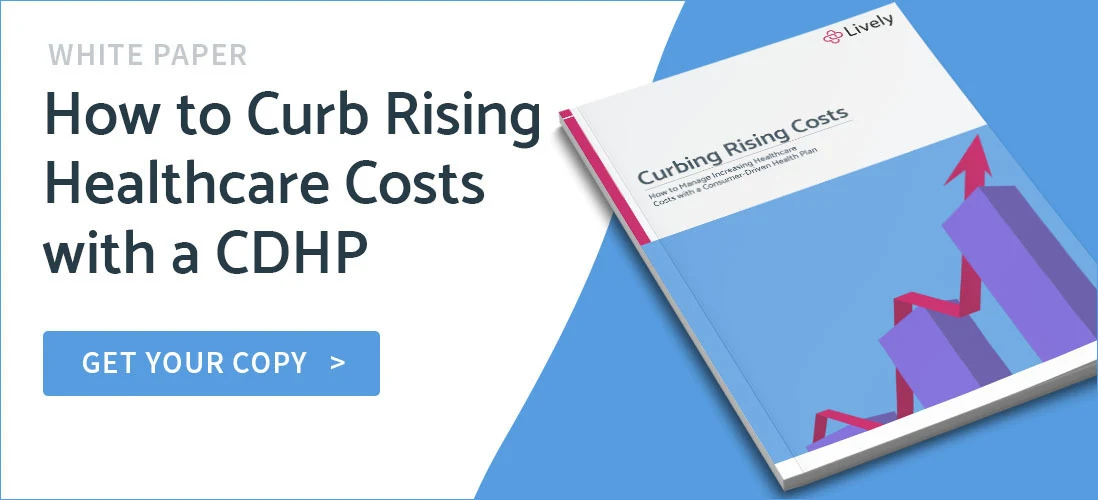The Lively Blog
SIGN UP FOR OUR
Newsletter
Stay up to date on the latest news delivered straight to your inbox
Health Insurance Premiums are Rising. Are You Prepared?
Renee Sazci · April 23, 2020 · 7 min read

Medical Costs Are Increasing Faster than Wages or Inflation
Increases to the cost of employer-sponsored health insurance premiums are currently outpacing the rate of inflation and employee wages. Between 2018 and 2019, inflation increased by 2%, and workers’ wages increased a mere 3.4%, while the average individual premium increased by 4%, and the average family premium increased by 5%. In 2019, across all health insurance plan types, employers contributed, on average, $5,946 for an individual employee’s plan and $14,561 for an employee’s family plan. And employees contributed $1,242 for an individual employer-sponsored plan and $6,015 for an employer-sponsored family plan. When the annual rate of health insurance premium increases are compounded over time, the rate of inflation is astounding.
The total cost of the average employer-sponsored family health insurance premium increased from $13,375 in 2009 to $16,834 in 2014, and then $20,576 in 2019. Overall, premiums for family health insurance coverage increased by a staggering 54% between 2009 and 2019. Over the past ten years, employer contribution costs increased by 48%, while employees contributed 71% more towards the cost of their healthcare premiums than in 2009. These premium increases cause employers to endeavor to strike a balance between cost efficiencies and employee wellness, while employees spend a more significant proportion of their income on healthcare costs. It is projected that these healthcare costs will continue to climb.

The Projected Increase
The Centers for Medicare and Medicaid Services released their National Health Expenditure Projections report for 2019-2028 prior to unprecedented changes that coronavirus (COVID-19) has brought to Americans and the healthcare sector. Their 2019-2028 healthcare spending projections were based on historical data from 2018 and did not account for the highly uncertain nature of the pandemic. As of the date of the report’s March 23, 2020 release, it's projected that private health insurance premiums might grow an average of 4.65% per year between 2019 and 2028—that’s an estimated 41.85% increase over nine years—and that premiums will continue growing faster than inflation and worker’s wages.
Their “business-as-usual” projections estimate that total healthcare spending per person—including service costs and funding for those services, such as health insurance premiums and out-of-pocket expenditures—could grow from $11,000 in 2017 to $17,000 by 2027. These estimates are based on the expected increase in the average deductible for those enrolled in private health insurance plans, as well as costs associated with the estimated 31.5 million uninsured individuals as of 2019.
Health Insurance Premiums Post-Coronavirus (COVID-19)

The Coronavirus (COVID-19) has brought heightened healthcare cost uncertainty to employers and employees. Health carriers are in the process of setting rates for 2021, and there has been much speculation about how much health insurance premium increases will climb from COVID-19 alone.
Covered California released a report that projects 2021 premium increases to individuals and employers, from COVID-19 alone, could range from 4% (9% in total) to more than 40% (45% in whole), on top of the 5% projected increases (March 22, 2020).
Willis Towers Watson’s Best Practices in Health Care Employer Survey estimates that because of COVID-19 testing and treatment, health insurance premiums could jump as much as 7% on top of the 5% increase (12% in total) employers previously projected for 2021 (March 26, 2020).
On the other hand, eHealth Inc. surveyed their health insurers and 83% of insurer respondents said that they do not anticipate raising rates in 2021 as a result of the crisis (April 2, 2020).
An April 15, 2020 study by Peterson-KFF, on how health costs might change from COVID-19, summed up the general sentiment for most estimates:
“The costs of coronavirus testing and COVID-19 treatment are expected to be high, reaching tens if not hundreds of billions of dollars, but there is extreme variation in estimates due to remaining uncertainty about the extent of the outbreak. Additionally, other care, such as for elective procedures and some outpatient care or pharmacy use, is likely to be forgone as hospitals take measures to free up capacity for COVID-19 patients and individuals put off care due to less access under social distancing orders or concerns over contracting the virus. On net, health spending could be higher this year and next than otherwise expected before the pandemic hit, but it is yet to be seen how upward and downward cost pressures will balance out."
While the impact of COVID-19 has led to different projections of the economic effects and many unknowns, the good news is that since the reports were published, new legislation has been directed at managing these costs. Regardless, an increase in health care spending and higher insurance premiums are likely.
How HDHPs Help You Save on Healthcare

As health insurance premiums continue to rise, employers and employees are searching for ways to manage their health cost-effectively. A Consumer-Driven Health Plan’s (CDHP) premium is lower when compared to a standalone PPO or HMO; on average, $776 less per individual employee plan and $1,596 less per family employee plan per year. An example of a CDHP is an HSA-eligible health plan, like a High-Deductible Health Plan (HDHP) coupled with a Health Savings Account (HSA).
For employers, CDHPs offer a lower premium, as well reduction in employer payroll taxes by 7.65% of total contributions (employer’s half of FICA and FUTA). For employees, a consumer-driven health plan is a viable option for those that have low healthcare utilization, or would otherwise max-out their out-of-pocket spending. The premium savings can be contributed to a triple tax-advantaged Health Savings Account to grow their financial safety net.
What is a Health Savings Account?
A Health Savings Account, or HSA, is a triple tax-advantaged savings account where pre-tax funds are deposited to grow tax-free, and when withdrawn for qualified medical expenses are tax-free. The Health Savings Account is a complement to the High-Deductible Health Plan, that enables participants to pay for the deductible, qualified medical expenses, and future health expenses with tax-advantaged funds. Plus, the balance rolls over year-to-year, so the funds never “expire” and can be used to invest in their health. An HSA is also like a 401(k), but better.
Average Employee Costs in Retirement
While employees are concerned about their immediate healthcare spending, many don’t realize that a healthy couple retiring in 2019 may spend $285,000 in retirement on healthcare alone. For those not retired as of last year, future healthcare costs must account for a 2% inflation rate, and if we stay on par for the past decade’s premium inflation rate, a 5% annual health insurance premium increase (If health insurance increases continue at roughly 5% per year for the next 30 years, those in retirement could realize at least a 150% increase from today’s rates). Under the assumption that the U.S. healthcare system is much like it is today, for a 35-year-old couple retiring in 30 years, the future value of $285,000 with a 2% inflation rate—alone—equates to $516,238. This amount excludes anticipated increases in the cost of healthcare, such as health insurance premiums and out-of-pocket costs, and only represents what today’s dollars might resemble in three decades. Brokers and employers are inspired to find ways to balance costs today with employee health and long-term financial wellness.
Discover how a Consumer-Driven Health Plan can help manage increasing healthcare costs, including health insurance premiums. Download the white paper below.

Benefits
2025 and 2026 Maximum HSA Contribution Limits
Lively · June 20, 2025 · 3 min read
On May 1, 2025, the IRS announced the HSA contribution limits for 2026: $4,400 for individual coverage and $8,750 for family coverage. That’s a $100–$200 increase from the 2025 limits, which are $4,300 and $8,550 respectively. If you’re 55 or older, you can still contribute an extra $1,000.

Benefits
What is the Difference Between a Flexible Spending Account and a Health Savings Account?
Lauren Hargrave · February 9, 2024 · 12 min read
A Health Savings Account (HSA) and Healthcare Flexible Spending Account (FSA) provide up to 30% savings on out-of-pocket healthcare expenses. That’s good news. Except you can’t contribute to an HSA and Healthcare FSA at the same time. So what if your employer offers both benefits? How do you choose which account type is best for you? Let’s explore the advantages of each to help you decide which wins in HSA vs FSA.

Health Savings Accounts
Ways Health Savings Account Matching Benefits Employers
Lauren Hargrave · October 13, 2023 · 7 min read
Employers need employees to adopt and engage with their benefits and one way to encourage employees to adopt and contribute to (i.e. engage with) an HSA, is for employers to match employees’ contributions.
SIGN UP FOR OUR
Newsletter
Stay up to date on the latest news delivered straight to your inbox

